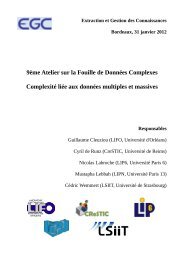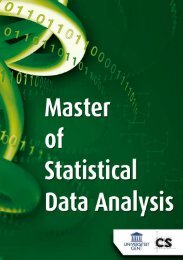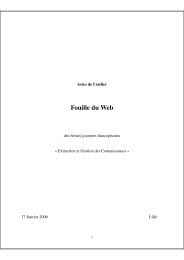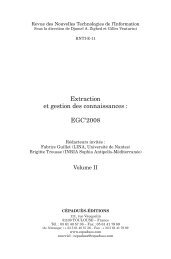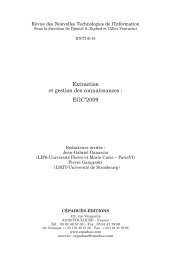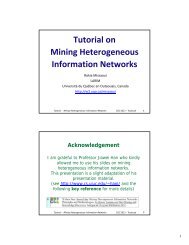télécharger egc10_atelier_fdc.pdf
télécharger egc10_atelier_fdc.pdf
télécharger egc10_atelier_fdc.pdf
Create successful ePaper yourself
Turn your PDF publications into a flip-book with our unique Google optimized e-Paper software.
Fusion de segmentation et classification automatique d’images sonar<br />
giner l’implémentation d’approches plus complexes afin de combiner les résultats. La théorie<br />
des fonctions de croyance est par exemple un cadre envisageable. Enfin, il est important de<br />
garder à l’esprit que la présence d’un expert est toujours indispensable pour la phase d’apprentissage.<br />
Les experts indiquant leur degré de certitude, ce dernier pourrait être employé pour un<br />
meilleur apprentissage des approches supervisées. L’utilisation de méthodes de classification<br />
non-supervisées pourrait également permettre d’obtenir une segmentation de l’image.<br />
Références<br />
Artigues, S. et C. Billard (2005). Logiciel de segmentation et de classification automatique de<br />
sédiments marins. Technical report, Projet industriel, ENSIETA.<br />
Haralick, R. (1979). Statistical and textural approaches to textures. Proceedings of the<br />
IEEE 67(5), 786–804.<br />
Laanaya, H. (2007). Classification en environnement Incertain : Application la Caractérisation<br />
de Sédiments Marins. Ph. D. thesis, Université de Bretagne Occidentale, ENSIETA, Brest.<br />
Le Chenadec, G. et J.-M. Boucher (2005). Sonar image segmentation using the angular dependence<br />
of backscattering distributions. In IEEE Oceans’05 Europe, Brest, France.<br />
Leblond, I., M. Legris, et B. Solaiman (2005). Use of classification and segmentation of sidescan<br />
sonar images for long term registration. In IEEE Oceans’05 Europe, Brest, France.<br />
Lengrand-Lambert, J. (2009). Fusion de la segmentation et de la classification automatique<br />
des images sonar. Technical report, Projet industriel, ENSIETA.<br />
Martin, A., H. Laanaya, et A. Arnold-Bos (2006). Evaluation for uncertainty image classification<br />
and segmentation. Pattern Recognition 39(11), 1987–1995.<br />
Martin, A., G. Sévellec, et I. Leblond (2004). Characteristics vs decision fusion for sea-bottom<br />
characterization. In Journée d’Acoustique Sous-Marine, Brest, France.<br />
Pasini, S. et B. Grandgeorge (2003). Image segmentation. Projet en Digital Photography -<br />
Image Segmentation 1, 5–9.<br />
Russ, J. C. (2002). The image processing handbook. Cleveland: CRC Press.<br />
Sumenger, B. (2005). Level set method presentation. Technical report, Vision Research Lab,<br />
UCSB.<br />
Summary<br />
This issue handles the ability of processing sonar images in order to automatically draw a<br />
map of undersea borders and classes. This study takes part of the project of automatic undersea<br />
cartography. Indeed, the current use of experts to analyse those images is very long and costs<br />
money. In addition, two experts have almost always different points of view on the same<br />
image. This work is based on an older software capable of automatically classify images<br />
using a learning database. In order to enhance its results, we worked on a different way of<br />
segmentation using the ‘level-sets method’. Then, we tried to fuse the two results. Finally, this<br />
issue allows us to draw a conclusion of such a method and to explore deeper in this way.



